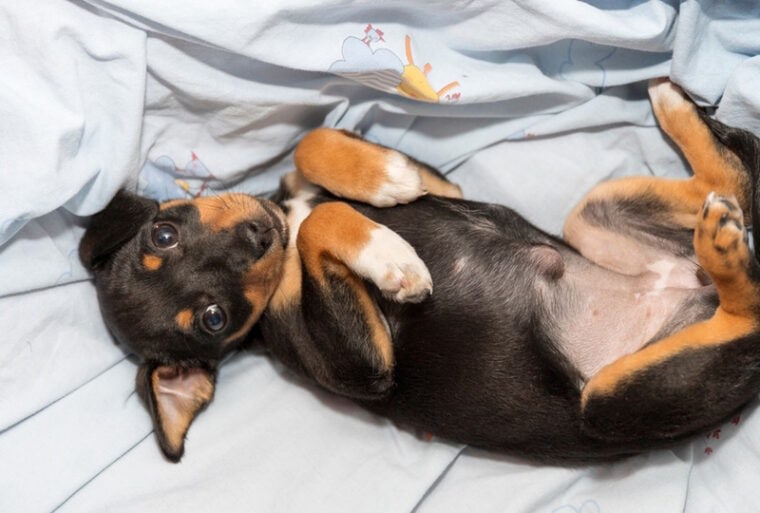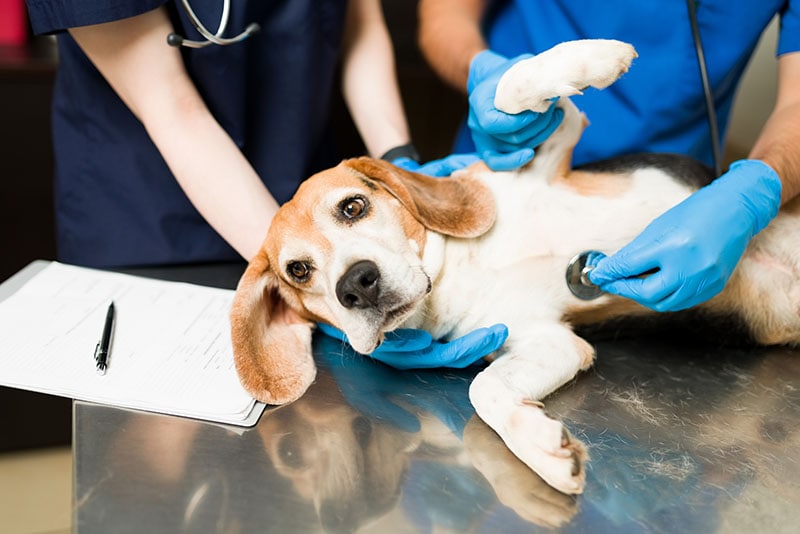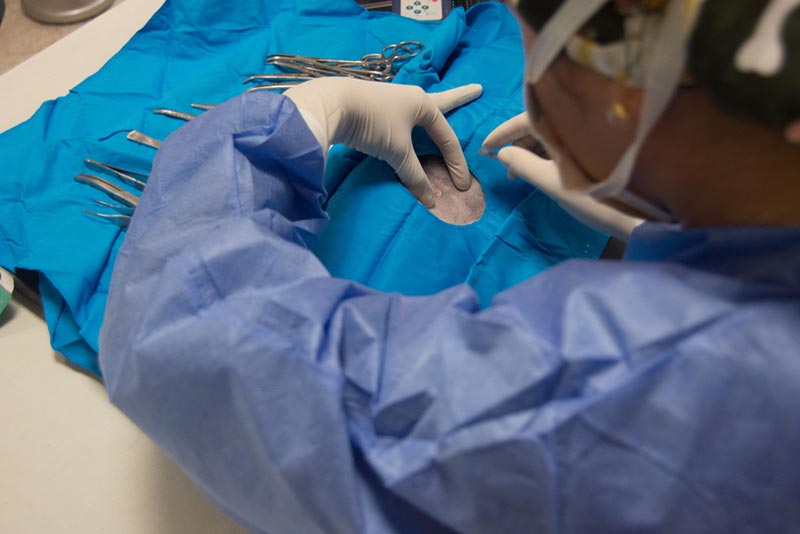
Click to Skip Ahead
Ever wondered why no one talks about dogs having an outie or an innie belly button? All dogs have a very smooth scar where their umbilical cord used to be (the belly button), and if they have anything that resembles an outie or innie belly button, that is cause for concern. If anything seems to be protruding from your dog’s belly button or if you can press your finger into this spot, it’s likely that they have something called an umbilical hernia.
What’s an umbilical hernia, and what does this mean for your dog? Read on to find out!
What Is an Umbilical Hernia in Dogs?
To know what an umbilical hernia is, we must know what a hernia is and what the umbilicus is. A hernia is a protrusion of tissue, often an organ, through the wall of the cavity that usually contains it. The umbilicus is the medical term for a belly button. It’s the spot on the abdomen where the umbilical cord used to be attached to mammals.
An umbilical hernia, therefore, is a hernia of the abdominal wall at the site of the umbilicus and usually contains abdominal fat and potentially abdominal organs such as the small intestines.

What Are the Causes of an Umbilical Hernia in Dogs?
In most cases, umbilical hernias are presumed to occur due to genetics, though trauma to the area is another potential cause. When a puppy is still a fetus, the blood supply that carries nutrients to them from the placenta travels from the umbilical cord and through the abdominal wall of the body at the umbilical ring.
After the puppy is born and the umbilical cord is severed, the hole in the abdominal wall that previously let blood vessels through is supposed to close in on itself, but in some cases, the umbilical ring remains open, and an umbilical hernia forms.
What Are the Signs of an Umbilical Hernia in Dogs?
On a dog, you will find the umbilicus on their belly, midline near the end of their ribcage. If you roll your dog on their back, an umbilical hernia will usually look and feel like a fatty lump at that spot which can sometimes be pressed or squeezed back into the abdomen, leaving a hole with a ring that can be felt with your finger. Some umbilical hernias are best seen or felt while the dog is standing.
Be careful to check the area gently and not to try to force tissue back through the hole as not all umbilical hernias allow the tissues to readily pass back and forth past the abdominal wall. Umbilical hernias can be about as small as a marble or as large as a baseball. Some umbilical hernias may be painful to the touch or change color.
While many umbilical hernias do not cause a problem for a dog, if an intestinal loop is stuck and strangled within the hernia, a dog may show the following signs:

How Umbilical Hernias in Dogs Are Diagnosed
A veterinarian can diagnose an umbilical hernia with just a physical exam in most cases, especially if the hernia is reducible, meaning a type that can be manipulated back inside the abdominal wall. If a doctor isn’t certain of an umbilical hernia by touch, an ultrasound can be used to confirm the presence of intestinal loops inside the hernia. Rarely and only in exceptionally large umbilical hernias could an x-ray be considered too.
How Umbilical Hernias in Dogs Are Treated
Though most umbilical hernias never cause a problem, as long as they are present, there is a risk of an intestinal loop becoming trapped in the hernia. For this reason, it is recommended to close the hernia, which is done with surgery. Since most animals will be diagnosed young, it is common to perform this surgery during their spay or neuter, but they can receive this surgery at any age as long as they are healthy enough for surgery.
How Do I Care for a Dog With an Umbilical Hernia
Prior to surgery, it is best to regularly check in on your dog’s umbilical hernia for changes in size, changes in feel (such as becoming firmer), or signs of pain.
Dogs that receive surgery to close their umbilical hernia need to wear an Elizabethan collar for about two weeks, and if they have any external stitches, those will need to be removed around that time also. Be sure to keep your dog calm and still with no running or jumping until their veterinarian clears them to prevent the site from reopening. No one wants to have repeat corrective surgeries!

Frequently Asked Questions (FAQs)
Can a dog live with an umbilical hernia?
Yes, they can. Though complications from an umbilical hernia are rare, since there is a risk of harm, it is generally recommended to close them surgically if possible.
Can an umbilical hernia heal itself in dogs?
No, an umbilical hernia in dogs will not close on its own. A simple and fast surgery can close this hole instead.
How much does it cost to fix an umbilical hernia in a dog?
Cost can vary widely, especially considering if this is a puppy or an adult and a large breed or a small one. In some cases, spaying a dog can include cutting over the umbilicus and so some surgeons include the cost to correct an umbilical hernia in a female dog with the cost of a spay. The cost of living in your area also greatly impacts surgical costs. As a general estimate, you can expect to pay around $100–$600 for an umbilical hernia repair.

Conclusion
A dog’s belly button should always be nearly smooth, and a bump in this area may be due to an umbilical hernia. If you notice something like this on your dog, you should bring them to their veterinarian for an exam. If your dog has an umbilical hernia, they will likely be just fine though your veterinarian will usually recommend surgery to close the hernia before it can cause any problems. This is a simple surgery with an easy recovery and your dog should be back to normal in no time after getting this fixed.
Featured Image Credit: Tatiana Cutrone, Shutterstock







